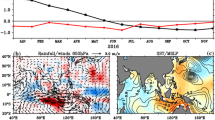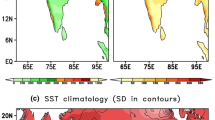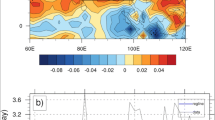Abstract
Though over a century long period (1871–2010) the Indian summer monsoon rainfall (ISMR) series is stable, it does depict the decreasing tendency during the last three decades of the 20th century. Around mid-1970s, there was a major climate shift over the globe. The average all-India surface air temperature also shows consistent rise after 1975. This unequivocal warming may have some impact on the weakening of ISMR. The reduction in seasonal rainfall is mainly contributed by the deficit rainfall over core monsoon zone which happens to be the major contributor to seasonal rainfall amount. During the period 1976–2004, the deficit (excess) monsoons have become more (less) frequent. The monsoon circulation is observed to be weakened. The mid-tropospheric gradient responsible for the maintenance of monsoon circulation has been observed to be weakened significantly as compared to 1901–1975. The warming over western equatorial Indian Ocean as well as equatorial Pacific is more pronounced after mid-70s and the co-occurrence of positive Indian Ocean Dipole Mode events and El Nino events might have reinforced the large deficit anomalies of Indian summer monsoon rainfall during 1976–2004. All these factors may contribute to the weakening of ISMR.











Similar content being viewed by others
References
Clark CO, Cole JE, Webster PJ (2000) Indian Ocean SST and Indian summer rainfall: predictive relationships and their decadal variability. J Climate 13:2503–2519
Ferranti L, Slingo JM, Palmer TN, Hoskins BJ (1997) Relations between interannual and intraseasonal monsoon variability as diagnosed from AMIP integrations. Q J R Meteorol Soc 123:1323–1357
Gadgil S, Vinaychandran PN, Francis PA, Gadgil S (2004) Extremes of the Indian summer monsoon rainfall, ENSO and equatorial Indian Ocean oscillation. Geophys Res Lett 31:L12213
Goswami BN (1998) Inter-annual variations of Indian monsoon in a GCM: external conditions versus internal feedback. J Climate 11:501–522
Goswami BN, Mohan RSA (2001) Intraseasonal oscillations and interannual variability of the Indian summer monsoon. J Climate 14:1180–1198
Goswami BN, Venugopal V, Sengupta D, Madhusoodanan MS, Xavier PK (2006) Increasing trend of Extreme Rain Events over India in a Warming Environment. Science 314:1442–1445
Guhathakurta P, Rajeevan M (2008) Trends in the rainfall pattern over India. Int J Climatol 28:1453–1469
IPCC (2007) Summary for policymakers. In: Solomon S, Qin D, Manning M, Chen Z, Marquis M, Averyt KB, Tignor M, Miller HL (eds) Climate change 2007: the physical science basis. Contribution of Working Group I to the Fourth Assessment Report of the Intergovernmental Panel on Climate Change. Cambridge University Press, Cambridge
Kalnay E et al (1996) The NCEP/NCAR 40-year reanalysis project. Bull Am Meteorol Soc 77:437–471
Kothawale DR, Munot AA, Borgaonkar HP (2008) Temperature variability over the Indian ocean and its relationship with Indian summer monsoon rainfall. Theor Appl Climatol 92:31–45
Kothawale DR, Munota A, Krishna Kumar K (2010) Recent trends in pre-monsoon daily temperature extremes over India. J Earth Syst Sci 119:51–65
Kripalani RH, Kulkarni A (1997) Climatic impact of El Nino/La Nina on the Indian monsoon: a new perspective. Weather 52:39–46
Kripalani RH, Kulkarni A (1999) Climatology and variability of Historical Soviet Snow Depth Data: some new perspectives in Snow-Indian monsoon teleconnections. Clim Dyn 15:475–489
Kripalani RH, Kulakrni A, Sabade SS (2001) El Nino Southern Oscillation, Eurasian snow cover and Indian monsoon rainfall. Proc Indian Natl Sci Acad 67(A):361–368
Kripalani RH, Kulkarni A, Sabade SS (2003) Western Himalayan snow cover and Indian monsoon rainfall: a re-examination with INSAT and NCEP/NCAR. Theor Appl Climatol 72:1–18
Kripalani RH, Kulkarni A, Sabade SS, Revadekar JV, Patwardhan SK, Kulkarni JR (2004) Intra-seaonal oscillations during monsoon 2002 and 2003. Curr Sci 87:325–334
Krishna Kumar K, Rajgopalan B, Hoerling M, Bates G, Cane M (2006) Unraveling the mystery of Indian monsoon failure during El Nino. Science 314:115–119
Kulkarni A, Sabade SS, Kripalani RH (2006) Intra-seasonal vagaries of Indian summer monsoon rainfall. Research Report of Indian Institute of Tropical Meteorology, India, No RR-114, pp 51
Kulkarni A, Sabade SS, Kripalani RH (2009) Spatial variability of intra-seasonal oscillations during extreme Indian monsoons. Int J Climatol 29:1945–1955
Mooley DA, Shukla J (1987) Variability and forecasting of the summer monsoon rainfall over India. In: Chang CP, Krishnamurti TN (eds) Monsoon Meteorology (Oxford Monograph on Geology and Geophysics, No. 7, p. 544), Oxford University Press, New York, pp. 26–59
Rajeevan M, Bhate J, Kale JD, Lal B (2006) High resolution daily gridded rainfall data for the Indian region: analysis of break and active monsoon spells. Curr Sci 91:296–306
Rajeevan M, Bhate J, Jaswal AK (2008) Analysis of variability and trends of extreme rainfall events over India using 104 years of gridded daily rainfall data. Geophys Res Lett 35:L18707
Saji NH, Goswami BN, Vinayachandran PN, Yamagata T (1999) A dipole mode in the tropical Indian Ocean. Nature 401:360–363
Shepard D (1968) A two-dimensional interpolation function for irregularly-spaced data. Proceedings of the 1968 23rd ACM National Conference. Assoc. Comput. Mach, New York, pp 517–524
Shukla J (1975) Effect of Arabian Sea surface temperature anomaly on Indian summer monsoon: a numerical experiment with the GFDL Model. J Atmos Sci 32:503–511
Shukla J (1987) Interannual variability of monsoons. In: Monsoons. Jay S.Fein and Pamela L. Stephens (eds), John Wiley & Sons, Inc., pp. 399-464
Shukla J, Mooley DA (1987) Empirical prediction of the summer monsoon rainfall over India. Mon Weather Rev 115:695–703
Sperber KR, Slingo JM, Annamalai H (2000) Predictability and the relationship between subseasonal and interannual variability during the Asian summer monsoon. Q J R Meteorol Soc 126:2545–2574
Xavier PK, Goswami BN (2007) Promising alternative to prediction of seasonal mean all India rainfall. Curr Sci 93:195–202
Acknowledgements
Author wish to thank Dr B N Goswami, Director, Indian Institute of Tropical Meteorology (IITM), Dr R Krishnan, Executive Director, Center for Climate Change Research, IITM for all the facilities provided. The valuable suggestions by the anonymous reviewers are duly acknowledged. Author is grateful to India Meteorological Department for providing the century long high resolution daily rainfall data on the Indian domain.
Author information
Authors and Affiliations
Corresponding author
Rights and permissions
About this article
Cite this article
Kulkarni, A. Weakening of Indian summer monsoon rainfall in warming environment. Theor Appl Climatol 109, 447–459 (2012). https://doi.org/10.1007/s00704-012-0591-4
Received:
Accepted:
Published:
Issue Date:
DOI: https://doi.org/10.1007/s00704-012-0591-4




